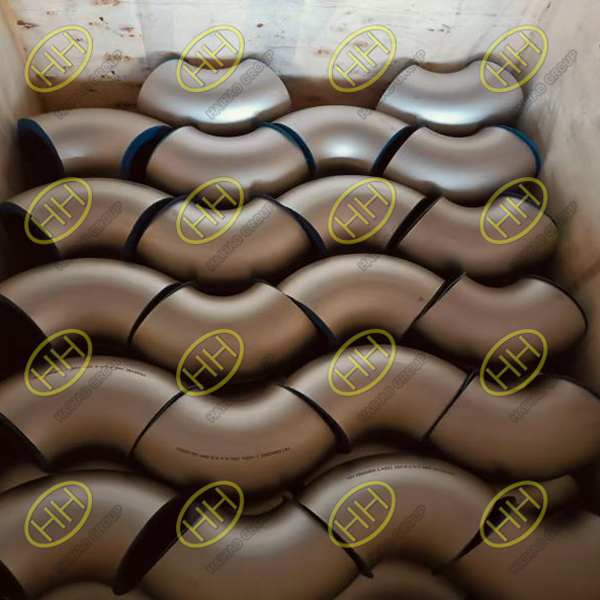How many types of elbows are used in piping systems?
Elbows are fundamental components in any pipeline system, allowing engineers to design efficient layouts, bypass obstacles, and integrate equipment seamlessly. They are categorized in numerous ways, each type serving specific purposes based on the required angle, connection method, pipe size, material, and operational demands. Understanding these classifications is crucial for ensuring the integrity, safety, and longevity of any piping installation.
This complete guide will delve into the various types of elbows used in piping systems, offering a comprehensive overview to help you make informed decisions for your next project.
1.Classification by Bending Angle
The most intuitive way to classify elbows is by the degree to which they change the flow direction.

DIN2605 304L 90° SMLS Elbows produced by Haihao Group
90-Degree Elbow
This is by far the most commonly used elbow type. A 90-degree elbow redirects the flow at a right angle (90°), making it ideal for sharp turns in piping layouts, such as when changing direction horizontally to vertically, or vice versa, or making a corner in a room.

45 Degree Long Radius Elbows BS1965 P265GH
45-Degree Elbow
As its name suggests, a 45-degree elbow changes the direction of flow by 45 degrees. These are used when smoother, less abrupt directional changes are needed, minimizing pressure drop and turbulence compared to 90-degree bends, or when making slight offsets in a pipe run.

ASME B16.9 A106 Gr. B SR 180° elbows
180-Degree Return Elbow
A 180-degree return elbow (often called a “return bend”) is designed for a full flow reversal. It creates a U-turn in the pipeline, directing the flow back in the opposite direction. These are commonly found in heat exchangers, coil systems, and heating elements where fluids need to travel back and forth over a short distance.
2.Classification by Connection Type
Elbows come with various end preparations to facilitate different connection methods, suitable for diverse applications and pressure ratings.
2.1. Butt Weld Elbow (BW Elbow)
Description: These elbows have beveled ends designed to be welded directly to the pipe. This creates a continuous, permanent, and highly robust joint.
Applications: Ideal for high-pressure, high-temperature, and critical industrial applications where a strong, leak-proof, and seamless connection is essential. They are very common in oil & gas pipelines, chemical processing, and power generation due to their inherent strength and integrity. Butt weld elbows are available in a vast range of sizes, from small diameters to several feet in diameter.

ASME B16.11 90° socket weld elbows A350 GR. LF2 CL1 NACE MR0175
2.2. Socket Weld Elbow (SW Elbow)
Description: Socket weld elbows feature a recessed “socket” on one or both ends where the pipe is inserted before being fillet welded.
Applications: Primarily used in small diameter pipelines (typically NPS 4 or less) for high-pressure and high-temperature services where leak prevention is crucial. They offer a strong, leak-resistant connection, often used in instrument lines and steam lines.

Stainless steel forged threaded elbow A182 F316 90 degree
2.3. Threaded Elbow (Screwed Elbow)
Description: Threaded elbows have internal (female) or external (male) pipe threads on their ends, allowing them to be screwed onto threaded pipes or other fittings.
Variations:
Female Internal Pipe (FIP x FIP): The most common type of threaded elbow, with female threads on both ends, allowing it to connect to two male-threaded pipes or nipples.
Male Internal Pipe (MIP x FIP) / Street Elbow: (As detailed below, this is a specific configuration).
Applications: Favored for their easy installation and maintenance, threaded elbows are common in residential plumbing, fire protection systems, and low-to-medium pressure industrial applications where frequent assembly or disassembly might be required.
2.4.Flanged Elbow
Description: Flanged elbows have flat faces with bolt holes designed to be connected to mating pipe flanges using bolts and gaskets.
Applications: Typically used in systems that require easy disassembly and maintenance, or where connections to equipment with flanged nozzles are necessary. Common in larger diameter pipelines or systems with frequent inspection or equipment changes.
3.Classification by End Configuration
Beyond the connection type, elbows can also be classified by the configuration of their ends, particularly regarding male and female interfaces.
3.1.Standard Elbow
Description: This term generally refers to elbows where both ends have the same connection type and size. Examples include a butt-weld elbow with two butt-weld ends, a socket-weld elbow with two socket-weld ends, or a threaded elbow with two female threaded ends (FIP x FIP).
Use: These are the most conventional elbows used for general directional changes within a consistent piping run.
3.2.Street Elbow
Description: A street elbow is distinguished by having one male end and one female end of the same nominal pipe size. For threaded versions, this means one end has external (male) threads, and the other has internal (female) threads.
Advantages:This unique configuration allows for direct connection to another female-threaded fitting or valve without needing an additional pipe nipple. This saves space, reduces the number of fittings, and potentially lowers the number of leak points in threaded systems.
Use: Ideal for tight installations and connecting directly to equipment ports.

ASME B16.9 ASTM A860 WPHY60 long radius reducing elbow
3.3.Reducing Elbow
Description: A reducing elbow is designed to connect pipes of different diameters while simultaneously changing the direction of flow. It has one end larger than the other.
Use: Employed in systems where the flow volume or pressure needs to change after a directional shift, commonly seen in distribution systems with branch lines or systems with changing flow volumes.
4.Classification by Radius
The radius of an elbow refers to the curvature of its bend, significantly impacting flow characteristics and available space.

ASME B16.9 A234 WPB SR SMLS 90DEG Elbows
4.1.Short Radius Elbow (SR Elbow)
Description: The center-to-end dimension (radius of curvature) of an SR elbow is equal to 1 times the nominal pipe diameter (1D).
Characteristics: Due to its compact design, it offers a sharper turn.
Considerations: This sharp turn can lead to higher turbulence and a more significant pressure drop in the fluid flow.
Applications: Preferred when space is extremely limited and the impact of increased pressure drop is acceptable or accounted for in the system design.

ASME B16.9 A403 WP304 SMLS LR 90° elbows
4.2.Long Radius Elbow (LR Elbow)
Description: The center-to-end dimension (radius of curvature) of an LR elbow is equal to 1.5 times the nominal pipe diameter (1.5D).
Characteristics: Features a gentler curve than an SR elbow.
Advantages: Allows for smoother flow, significantly reducing turbulence and minimizing pressure drop.
Applications: Preferred for most piping systems where flow efficiency and reduced wear on the elbow (due to less erosion from turbulence) are important.
4.3.Custom/Extra Long Radius Elbow
Description:These elbows have a radius of curvature greater than 1.5D, often custom-fabricated.
Applications: Used in specialized applications where minimizing pressure drop is paramount, such as in slurry lines or systems handling very viscous fluids.
5.Classification by Material
The material of an elbow must align with the piping system’s material, the type of fluid being conveyed, and the operating environment.
5.1.Carbon Steel Elbows
Description: Made from carbon steel, offering good strength and cost-effectiveness.
Applications: Widely used in oil & gas, water treatment, power plants, and general industrial use for non-corrosive fluids at moderate temperatures and pressures.
5.2.Stainless Steel Elbows
Description: Alloyed with chromium (and often nickel), providing excellent corrosion resistance.
Applications: Essential in chemical, food and beverage, pharmaceutical, and wastewater industries where hygiene, purity, and resistance to aggressive chemicals are critical.
5.3.Alloy Steel Elbows
Description: Steels alloyed with elements like chromium, molybdenum, or vanadium to enhance properties.
Applications: Specifically designed for high-temperature and high-pressure services, such as in power generation, petrochemicals, and other demanding industrial processes.
5.4.PVC / CPVC / Plastic Elbows
Description: Made from various plastic polymers.
Applications: Common in residential plumbing, irrigation systems, and specific chemical applications where corrosion resistance to certain chemicals at lower pressures and temperatures is required.
6.Special-Purpose Elbows
Beyond the common classifications, some elbows are designed for highly specific applications.
6.1.Swivel Elbows
Description: These elbows incorporate a swivel joint, allowing one part of the elbow to rotate relative to the other.
Applications: Used in systems where alignment adjustments are needed during installation or where components require rotational flexibility after assembly, such as in loading arms or hydraulic lines with movable parts.
6.2.Instrumentation Elbows
Description: Small-diameter, high-precision elbows often with specific connection types (e.g., compression fittings).
Applications: Utilized in precise flow measurement or control systems, connecting instruments like pressure gauges or transmitters to the main process line. They ensure accuracy and reliability in sensitive applications.
6.3.Hygienic Elbows
Description: Made from high-grade stainless steel with a highly polished interior surface to prevent bacterial growth and accumulation of contaminants. They often feature specific connection types like tri-clamps.
Applications: Indispensable in sanitary applications within the food, beverage, dairy, pharmaceutical, and biotech industries where maintaining product purity and easy cleanability are paramount.
7.Selection Criteria for Elbow Types
Choosing the correct elbow for your piping system involves a careful evaluation of several critical factors:
7.1Pressure and Temperature Rating: The elbow must be capable of withstanding the maximum operating pressure and temperature of the system.
7.2Space Availability: Confined areas might necessitate the use of street elbows or short radius elbows.
7.3Maintenance and Installation Needs: Consider whether the system requires easy disassembly (flanged, threaded) or a permanent joint (butt-weld).
7.4Corrosion and Chemical Compatibility: The elbow material must be resistant to the fluid being transported and the external environment.
7.5Flow Direction and Turbulence Considerations: Long radius elbows are preferred for minimizing pressure drop and turbulence, especially in high-velocity systems.
7.6Cost-Effectiveness: Balance the initial cost of the fitting and installation with long-term performance, safety, and maintenance.
7.7Industry Standards and Regulations: Ensure compliance with all relevant codes and standards for your specific application (e.g., ASME, API, local building codes).
8.Partner with Haihao Group for Certified Pipe Fittings
At Haihao Group, we recognize the critical impact that every fitting has on the integrity and performance of your piping infrastructure. With extensive expertise in advanced pipe fitting manufacturing and supply, we offer a comprehensive range of high-quality directional fittings designed to meet the most demanding industry standards.
Our product portfolio includes ASME B16.9 butt-weld elbows (in various radii and sizes), ASME B16.11 forged socket-weld and threaded elbows, including street elbows. We provide customized solutions in premium materials like carbon steel, stainless steel, duplex, and alloy steel. We ensure in-stock availability, offer custom threading options (NPT, BSP, metric), and provide fast delivery with global shipping.
Contact Haihao Group today to request a quote or get expert technical advice tailored to your project’s unique requirements.

